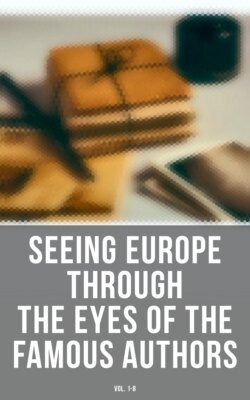Читать книгу Seeing Europe through the Eyes of the Famous Authors (Vol. 1-8) - Генри Джеймс - Страница 13
На сайте Литреса книга снята с продажи.
THE TEMPLE CHURCH1 By Augustus J.C. Hare
ОглавлениеTable of Contents
By Inner Temple Lane we reach the only existing relic of the residence of the Knights Templars in these courts, their magnificent Temple Church (St. Mary's), which fortunately just escaped the Great Fire in which most of the Inner Temple perished. The church was restored in 1839–42 at an expense of £70,000, but it has been ill-done, and with great disregard of the historic memorials it contained.
It is entered by a grand Norman arch under the western porch, which will remind those who have traveled in France of the glorious door of Loches. This opens upon the Round Church of 1185 (fifty-eight feet in diameter), built in recollection of the Round Church of the Holy Sepulcher, one of the only four remaining round churches in England; the others being at Cambridge, Northampton, and Maplestead in Essex. Hence, between graceful groups of Purbeck marble columns, we look into the later church of 1240; these two churches, built only at a distance of fifty-five years from each other, forming one of the most interesting examples we possess of the transition from Norman to Early English architecture. The Round Church is surrounded by an arcade of narrow Early English arches, separated by a series of heads, which are chiefly restorations. On the pavement lie two groups of restored effigies of "associates" of the Temple (not Knights Templars), carved in freestone, being probably the "eight images of armed knights" mentioned by Stow in 1598. …
Against the wall, behind the Marshalls, is the effigy of Robert Ros, Governor of Carlisle in the reign of John. He was one of the great Magna Charta barons, and married the daughter of a king of Scotland, but he was not a Templar, for he wears flowing hair, which is forbidden by the rites of the Order; at the close of his life, however, he took the Templars' habit as an associate, and was buried here in 1227. On the opposite side is a Purbeck marble sarcophagus, said to be that of Queen Eleanor of Aquitaine, but her effigy is at Fontevrault, where the monastic annals prove that she took the veil after the murder of Prince Arthur. Henry II. left five hundred marks by his will for his burial in the Temple Church, but was also buried at Fontevrault. Gough considers that the tomb here may be that of William Plantagenet, fifth son of Henry III., who died in infancy, and (according to Weaver) was buried in the Temple in 1256.
A staircase in the walls leads to the triforium of the Round Church, which is now filled with the tombs, foolishly removed from the chancel beneath. Worthy of especial notice is the colored kneeling effigy of Martin, Recorder of London, and Reader of the Middle Temple, 1615. Near this is the effigy—also colored and under a canopy—of Edmund Plowden, the famous jurist, of whom Lord Ellenborough said that "better authority could not be cited"; and referring to whom Fuller quaintly remarks: "How excellent a medley is made, when honesty and ability meet in a man of his profession!" There is also a monument to James Howell (1594–1666), whose entertaining letters, chiefly written from the Fleet, give many curious particulars relating to the reigns of James I. and Charles I. … The church (eight-two feet long, fifty-eight wide, thirty-seven high), begun in 1185 and finished in 1240, is one of our most beautiful existing specimens of Early English Pointed architecture: "the roof springing, as it were, in a harmonious and accordant fountain, out of the clustered pillars that support its pinioned arches; and these pillars, immense as they are, polished like so many gems."2 In the ornaments of the ceiling the banner of the Templars is frequently repeated—black and white, "because," says Fawyne, "the Templars showed themselves wholly white and fair toward the Christians, but black and terrible to them that were miscreants." The letters "Beausean" are for "Beauseant," their war cry.
In a dark hole to the left of the altar is the white marble monument of John Selden, 1654, called by Milton "the chief of learned men reputed in this land." The endless stream of volumes which he poured forth were filled with research and discrimination. Of these, his work "On the Law of Nature and of Nations" is described by Hallam as among the greatest achievements in erudition that any English writer has performed, but he is perhaps best known by his "Table Talk," of which Coleridge says, "There is more weighty bullion sense in this book than I ever found in the same number of pages of any uninspired writer." …
On the right of the choir, near a handsome marble piscina, is the effigy of a bishop, usually shown as that of Heraclius, Patriarch of Jerusalem, by whom the church was consecrated, but he left England in a fury, after Henry II. refused to perform his vow of joining the Crusades in person, to atone for the murder of Becket. The figure more probably represents Silverston de Eversdon, Bishop of Carlisle, 1255. In the vestry are monuments to Lords Eldon and Stowell, and that of Lord Thurlow (1806) by Rossi.
The organ, by Father Smydt or Smith, is famous from the long competition it underwent with one by Harris. Both were temporarily erected in the church. Blow and Purcell were employed to perform on that of Smith; Battista Draghi, organist to Queen Catherine, on that of Harris. Immense audiences came to listen, but tho the contest lasted a year they could arrive at no decision. Finally, it was left to Judge Jefferies of the Inner Temple, who was a great musician, and who chose that of Smith.
1 From "Walks in London."
2 Hawthorne.
